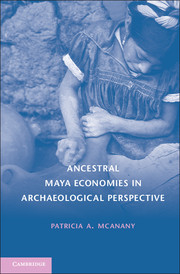Book contents
- Frontmatter
- Dedication
- Contents
- List of Figures
- Preface and Acknowledgments
- 1 The Materiality of Practice in Ancestral Maya Economies
- 2 Situating Maya Societies in Space and Time
- 3 Feeding a Hungry Landscape
- 4 Gendered Labor and Socially Constructed Space
- 5 Ritual Works: Monumental Architecture and Generative Schemes of Power
- 6 Naturalized Authority of the Royal Court
- 7 Social Identity and the Daily Practice of Artisan Production
- 8 Places, Practices, and People of Commerce
- 9 Flowery Speech of Maya Tributary Arrangements
- 10 Skeining the Threads
- References Cited
- Index
8 - Places, Practices, and People of Commerce
Published online by Cambridge University Press: 05 December 2014
- Frontmatter
- Dedication
- Contents
- List of Figures
- Preface and Acknowledgments
- 1 The Materiality of Practice in Ancestral Maya Economies
- 2 Situating Maya Societies in Space and Time
- 3 Feeding a Hungry Landscape
- 4 Gendered Labor and Socially Constructed Space
- 5 Ritual Works: Monumental Architecture and Generative Schemes of Power
- 6 Naturalized Authority of the Royal Court
- 7 Social Identity and the Daily Practice of Artisan Production
- 8 Places, Practices, and People of Commerce
- 9 Flowery Speech of Maya Tributary Arrangements
- 10 Skeining the Threads
- References Cited
- Index
Summary
K'IWIK 1:tianguis, feria o mercado o plaza, donde venden y compran…; k'iwik likil kon ba'ba'l: feria o mercardo donde se venden muchas cosas … 2.K'IWIK SOTS' U KONOL NA 11: bazar, mercado…
Barrera Vásquez 1995:405And so goes the entry for k'iwik – a word for places at which things are bought and sold – in the dictionary of contemporary Yucatec Mayan compiled by Alfredo Barrera Vásquez. What is the antiquity of this term and of marketplace practices in the Maya region? And what can we say about the antiquity of the role of trader in ancestral Maya society and of their connections to royal courts and palatial precincts of power? These questions – so integral to the puzzle of ancestral economies – defy easy answers. The interrogation begins with an allegory or morality tale about traders pieced together by an epigrapher and an art historian and then moves on to consider media of convertibility, evidence of marketplaces, and approaches to reading the economic biography of things.
ALLEGORICAL SHAMING AND REHABILITATION OF GOD L
One of the extraordinary facts of artisan activity across Mesoamerica resides in the methods by which crafts were transported from their place of fabrication. Many products were loaded on to a back-rack (cacaste) or into a large net bag and shouldered by means of a tumpline across the forehead. Alternatively, goods could be trans-ported via canoe if feasible. No other means of transport existed save the palanquins upon which royalty were carried by porters.
- Type
- Chapter
- Information
- Ancestral Maya Economies in Archaeological Perspective , pp. 253 - 268Publisher: Cambridge University PressPrint publication year: 2010

